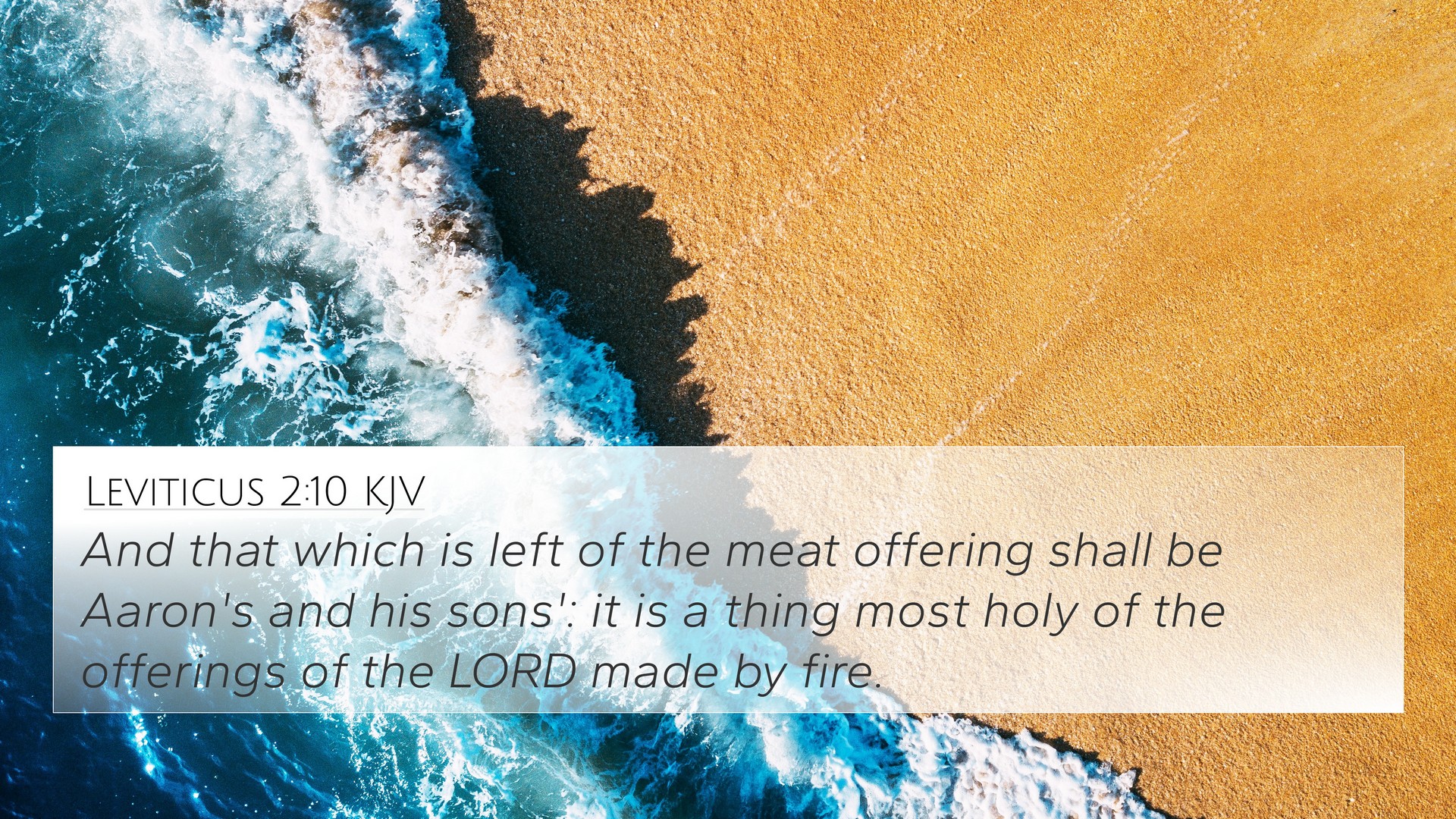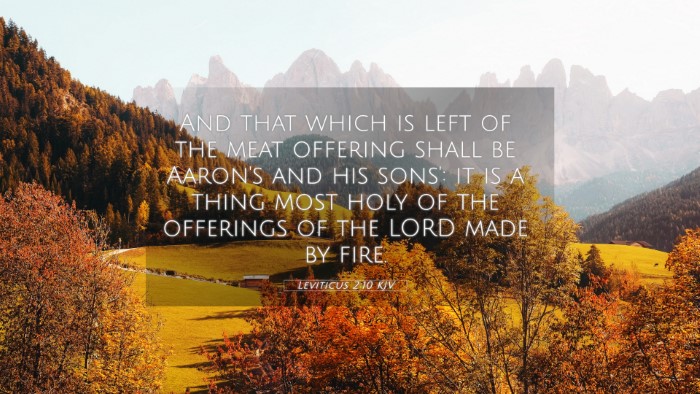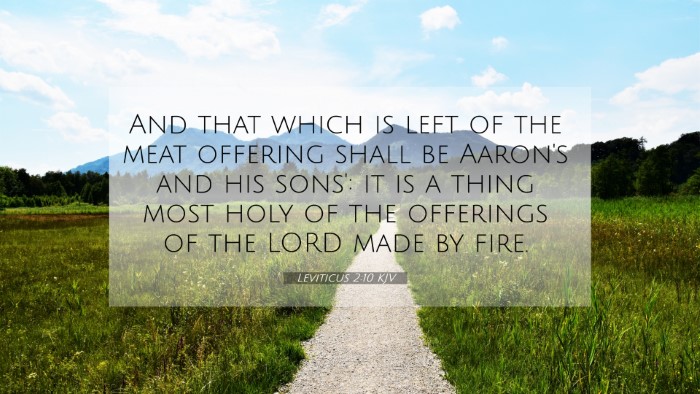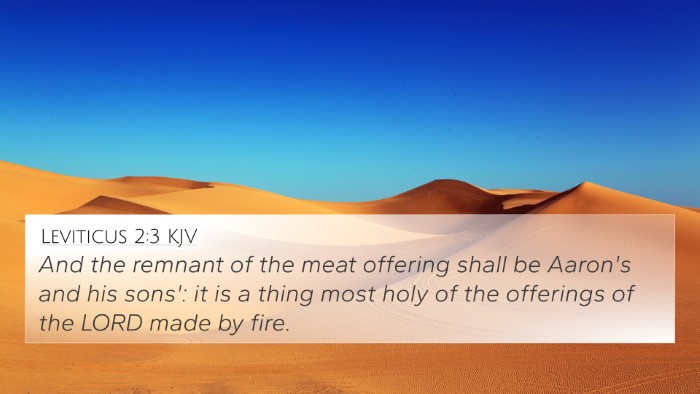Introduction to Leviticus 2:10
Leviticus 2:10 states, "And that which is left of the meat offering shall be Aaron's and his sons: it is a thing most holy of the offerings of the Lord made by fire." This verse requires examination to understand the significance of the meat offering, who it is designated for, and its holiness in the context of sacrificial practices.
Meanings and Insights from Public Domain Commentaries
-
Matthew Henry's Commentary
Matthew Henry emphasizes the importance of distinguishing between the offerings. The meat offering is not an animal sacrifice but rather a grain offering, representing the worshiper's acknowledgment of God's provision and blessings. The leftover portion signifies divine ownership and the holiness assigned to the priests, Aaron and his sons, affirming their role in mediating between God and the people.
-
Albert Barnes' Commentary
Albert Barnes focuses on the details of the offerings, indicating that they were to be presented with care and reverence. He highlights that the meat offering was often made in conjunction with animal sacrifices, enriching the sacrificial system's complexity. The indication that the remainder belongs to the priests points to their sustenance being tied to their spiritual role, fulfilling their duties and highlighting God's provision.
-
Adam Clarke's Commentary
Adam Clarke also comments on the significance of the meat offering in the worship context, pointing out its role in expressing gratitude and devotion to God. Clarke suggests that the offering symbolizes the assimilation of the faithful into God's service, further emphasizing that the holiness of the offering extends to Aaron and his descendants, who are the appointed leaders of public worship.
Cross References Related to Leviticus 2:10
- Leviticus 2:1-3: Discusses the preparation and presentation of the grain offering, indicating its nature and part of the priests' provision.
- Exodus 29:28: Relates to the portions required for Aaron and his sons from the sacrifices, reinforcing their holy role.
- Numbers 18:8-9: Expands upon the duties and allowances for the priests concerning offerings made to the Lord.
- Hebrews 7:13-14: Mentions the priesthood of Aaron in relation to Jesus Christ, drawing a connection to the New Testament context of sacrifice.
- Leviticus 6:16: Explains further the holy nature of remnants from the grain offering, detailing what priests are to do with it.
- Deuteronomy 18:1-2: Covers the rights of the priests, emphasizing their unique position regarding offerings and their inheritance.
- Matthew 5:23-24: Jesus teaches about coming to terms with God's requirements in worship and offerings, relating to the heart's condition.
Connecting Themes within the Verse
The connections within Leviticus 2:10 reveal deeper themes such as:
- Holiness: The concept of something being 'most holy,' pointing to the sacredness of offerings to God.
- Provision: Understanding how God provides not only for the people but also for the priests through the offerings.
- Participation: The communal aspect of worship, recognizing the involvement of both the laity (worshippers) and the clergy (Aaron and his sons).
Final Thoughts on Understanding Leviticus 2:10
This verse represents a critical element of the sacrificial system, emphasizing God's requirements for holiness and the designated roles of the priesthood. Acknowledging these details enriches one’s understanding of the inter-Biblical dialogue regarding sacrificial practices and their significance in worship.
Tools for Bible Cross-Referencing
For further study and understanding, tools for Bible cross-referencing can be tremendously beneficial:
- Bible Concordance: Useful for finding specific terms and their occurrences in the Bible.
- Bible Cross-Reference Guide: Provides structured pathways to connect related verses across the Scriptures.
- Cross-reference Bible Study: Methods for systematically studying connected themes within Bible verses.
Using Cross-References Effectively
To enhance your study of Bible verse cross-references, consider the following:
- Identifying connections between Old and New Testament passages.
- Exploring parallels between various biblical narratives and teachings.
- Engaging in thematic studies that explore cross-referenced themes.



